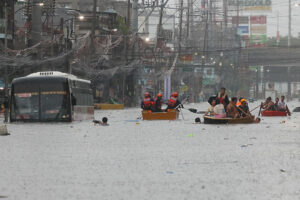By Kyle Aristophere T. Atienza, Reporter
PUBLIC and private assistance for victims of two storms that hit the Philippines and its neighbors in the region this month reached over P1 billion as of Saturday, according to the presidential palace, as the number of affected Filipinos climbed to over 8 million.
In an 8 a.m. report, a Philippine disaster agency said Severe Tropical Storm Trami, locally known as Kristine, and Super Typhoon Kong-Rey (Leon) had affected 2.2 million families or 8.63 million individuals.
Over 200,000 people or 56,396 families were staying in 467 evacuation centers, it added.
The death toll was at 146, and 125 of which were still for validation.
The Presidential Communications Office said in a statement food and non-food items provided by the Department of Social Welfare and Development (DSWD), Office of the Civil Defense (OCD), Local Government Units (LGUs), and nongovernment organizations (NGOs) to storm victims have reached P1.1 billion, as of Nov. 3.
The DSWD has released 1.01 million family food packs across regions affected by Trami and Kong-rey, it added.
For their part, the Armed forces of the Philippines had conducted 58 humanitarian sorties with the help of Southeast Asian countries in Naga City in Bicol Region and Batangas province in Calabarzon via land, air, and naval assets, the palace said.
Separately, Defense Secretary Gilberto C. Teodoro, Jr. said the Malaysian government had deployed a disaster management team to the Philippines to help in typhoon response efforts, commending their “swift response to our request for assistance.”
“Your support during this critical time has been invaluable in our recovery efforts following Severe Tropical Storm Kristine, and it exemplifies our strong partnership in times of need.”
Trami, which a green group dubbed as “third highly devastating weather event to batter the country this year,” submerged parts of the Bicol in flood waters, with local authorities saying 70% of residents of Naga City, one of the region’s major economic hubs, had been affected by the storm.
The storm left 59 people dead in Batangas province, 20 of whom were buried in a landslide in the municipality of Talisay, reports from local authorities last week showed.
The National Disaster Risk Reduction and Management Council (NDRRMC) said in its report that 75 of the 96 seaports affected were already operational and had resumed trips.
Over 180,000 houses were damaged, it said. Damage to infrastructure reached P7.2 billion
Moreover, damage to agriculture hit P4.5 billion, with 106,715 farmers and fisherfolk affected.
The Philippine northernmost province of Batanes was visited by a super typhoon just as Trami left, with the OCD Region II reporting “damage to houses and various crops, as well as landslides on major roads.”
The state weather bureau said in a 10 a.m. report on Sunday a low-pressure area (LPA) spotted 1,605 kilometers east of northeastern Mindanao has a “high chance” of developing into a tropical depression within the next 24 hours.
In a 4 a.m. briefing, the Philippine Atmospheric, Geophysical and Astronomical Services Administration (PAGASA) said the LPA may not directly affect the country in 24 hours but “may have the possibility to enter PAR (Philippine area of responsibility)” over the next 48 hours.
PAGASA said wind coming from the north-east that brings mild temperatures was expected to bring isolated light rains over Batanes and Babuyan Islands.
The government has already imposed a price freeze on basic necessities in areas under a state of calamity since Trami’s onslaught, and a fisherfolk group is calling for an expansion to cover fish.
Under a Philippine price law, a 60-day freeze can be activated following the declaration of a state of calamity, covering commodities such as canned fish, instant noodles that are locally manufactured, bread, bottled water, processed milk, laundry soap, salt, among others.
Fisherfolk group Pamalakaya at the weekend cited increasing market prices of fish including round scad (galunggong), whose cost rose to P220-240 per kilo from P180-200 per kilo prior to the onslaught of the storms.
The group cited tallies from its members at markets in the provinces of Cavite and Rizal, and Quezon City.
The price of tilapia fish and milkfish (bangus) also went up to between P160 and P180 per kilo and P180 per kilo, respectively, from P120-P150 per kilo, the group said.
“The typhoons and especially the fisherfolk are not to blame for the rising market price of fish but the private traders that take advantage of calamities to manipulate prices.”
Economists said more subsidies for local producers are needed amid devastation from storms.
‘DISASTER CAPITALISM’
“Price controls are not going to affect the quantity distortions caused by typhoons. This will only cause greater distortions and shortages as retailers will limit their sales, disincentivizing producers from selling,” Leonardo A. Lanzona, who teaches economics at Ateneo de Manila University said in a Facebook Messenger chat. “The only way to deal with cartels exploiting the situation is to empower non-cartel members, the small farmers and fishermen, to sell their goods directly to the buyers.
Rizal Commercial Banking Corp. Chief Economist Michael L. Ricafort said ensuring that traders would not exploit any price controls rests on strong law enforcement.
“Presence of law enforcers cannot be reduced,” he said, as he called for “delicate balance between supply and demand.”
John Paolo R. Rivera, a senior research fellow at the Philippine Institute for Development Studies, said temporary price controls post-calamity “would be helpful for consumers as they recover.”
Beyond supply-demand dynamics, price controls “regulate temporary market disequilibrium that results in opportunistic tendencies to raise prices or what we call disaster capitalism.”
“This prioritizes recovery of everyone —— consumers are able to buy and producers are able to generate revenues,” he said. “Survival first before capitalism.”

